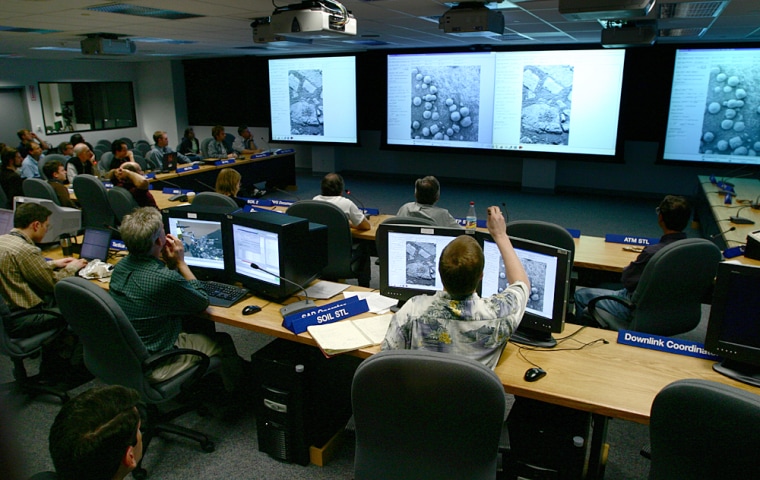8:30 to 9:15 a.m.: Each day, the rover's scientific operations have to fit within a three-dimensional box defined by time, data and energy.
The various teams draw up prioritized lists of the experiments they want to conduct, but it's up to the Science Operations Working Group to figure out how much they can get done in a day, how many bits of data can be downlinked, and how much of the rover's solar-generated electricity can be used. A software program called the Science Activity Planner, or SAP, is crucial for doing the accounting.
Opportunity's schedule for Sol 47 has already been roughed out using SAP, but it's well over budget — and that's just how science team leader Steve Squyres likes it. He wants to make sure there are plenty of experiments to choose from, so that not a second of the rover's time goes begging.
At the daily meeting, mission managers and lead scientists for the rover's instruments sit at tables arranged like three sides of a square, facing giant projection screens that are mounted on the wall beyond the open fourth side. Squyres presides at the central table.
Around the edges of the room sit other team members, including Matt Golombek, a veteran of the 1997 Mars Pathfinder mission, who is handling Spirit science operations and will take the stage for the news briefing later in the morning. Some of the back-benchers flit in and out as the meeting proceeds.

Topic A has to do with the blueberries displayed on the big screens. The rover planner for the shift, Eric Baumgartner, assures Squyres that the rover's robotic arm is precise enough to target a single blueberry, measuring only a tenth of an inch (3 millimeters) across.
Opportunity's Mössbauer spectrometer would be used to analyze the mineral composition of the target — which has been given the whimsical nickname of Mössberry.
"Why that one rather than that cluster of three to the right of it?" Squyres asks Daniel Rodionov, a young German researcher who is on the team for the Mössbauer spectrometer.
"If you miss Mössberry, you still get some berries," Rodionov explains.
"But Eric says he's going to get us to a third or a tenth of a berry," Squyres shoots back, raising a laugh from the group.
Squyres worries that Opportunity's robotic arm may have nudged Mössberry out of position during the previous round of observations, and he's still intrigued by the triple berry as an alternate target. "I don't think we're going to solve this at this particular moment," Squyres says.
With the blueberry question tabled, Squyres reviews the other proposed activities for Sol 47, displayed as a spreadsheet on the video screen.
The panoramic camera team wants to make a sky-column observation at midday, watch a solar eclipse by the Martian moon Phobos in the afternoon, and study a rock named Fool's Silver. The team in charge of Opportunity's miniature thermal emission spectrometer, or mini-TES, wants to conduct three low-elevation "sky stares" to analyze the Martian atmosphere. Another team wants to take pictures of magnets mounted on the rover itself, to measure the magnetic properties of Martian dust. The rover team wants to take more pictures of a rock formation called Shoemaker's Patio for navigation purposes.
Squyres looks at how the spreadsheet is toting up the time and the data. "Please tally total bits for me ... 88 [megabits] ... OK, I'm not going to lose sleep over that," he says. But the time required for all the observations is significantly over the allotted four hours.
"Let's make sure we've got the priorities straight so we can get close to that," Squyres says.
One of the mini-TES sky stares is dropped. Watching the eclipse is dubbed a Priority 2 item, but it remains on the table.
"The Pancam noon sky column is significantly at risk at 2," Squyres tells the group. "That's probably where I'm gonna go shopping if we're busted. I'll tell you right up front, I think there's a high chance that won't make it. But if that goes away, we're clearly in the bag."
At the end of the meeting, Squyres polls the team leaders around the table. "I'm not asking, do we make any changes. I'm just asking if you're happy with the plan," he says.
"Oh, I'm happy with the plan ... ecstatic," one scientist answers.
"Ecstatic ... that's what I like," Squyres says. "Scottie, are you ecstatic, or just happy?"
"I'm more than ecstatic," comes the reply.
"Bill, can you top that?" Squyres says.
"I'm super, extra ecstatic ..." Bill begins. Then the meeting dissolves into laughter.
